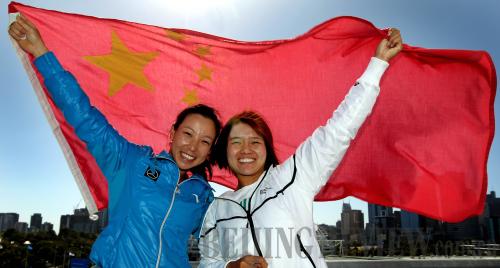|
 |
|
SMILING FACES: Zheng Jie (left) and Li Na hold the national flag after reaching the women's singles semifinals at the Australian Open on January 27 in Melbourne (XINHUA) |
Before the women's singles of this year's Australian Open kicked off in Melbourne Park on January 18, few people would have expected that two Chinese players, Li Na, 28, and Zheng Jie, 27, would reach the semifinals, making the best showing ever for Chinese tennis players at the four Grand Slams singles events.
"I think my entry in the semifinals will help tennis go up in China," Zheng Jie said after beating Maria Kirilenko of Russia 2-0 on January 26. The next day, Li Na upset American tennis player Venus Williams 2-1.
Although both Li and Zheng failed to reach the final, their performance attracted worldwide attention.
"Our presence at the semifinals is good not only for Zheng Jie and me, but also for Chinese tennis as a whole," Li Na said after the match. "The younger players in China will be confident on the court and believe they can make it in the future, as we did."
Timing matters
According to Sun Jinfang, Director of the Management Center of Tennis Sports under the State General Administration of Sport, the stunning performance of Li and Zheng has proved that the professionalization reform was successful.
The professionalization reform refers to players' managing their own careers rather than being managed by the state.
The government-controlled national system of sports is widely considered the key reason that China has become a sports power. Once a promising junior amateur was recruited to a local sports team and then to the national team, the state would cover everything until he or she retired. The Chinese national tennis team was no exception.
Tennis was first introduced to China in the late 19th century. The Chinese Tennis Association was established in 1953 after the founding of the People's Republic of China. It was not until 1981, however, that the team competed in its first-ever overseas tournament.
China became a leading power on the tennis court in Asia in the late 1980s, as Chinese players claimed titles at the Asian Games and World Universiade Games.
Unfortunately, the low level of training, lack of overseas tournament experience and insufficient number of foreign coaches led to disappointment at the 2002 Busan Asian Games as the team returned home empty-handed.
Consequently, the Management Center of Tennis Sports began to implement the long-awaited player's professional model, giving priority to women's tennis, especially women's doubles.
With more state funds, players were encouraged to participate in more international tournaments. The more tournaments they competed in, the more points they could earn, and the better chances they had to qualify for the Olympic Games.
The initial reform paid off. In 2004 alone, Zheng Jie reached the fourth round of the French Open, while Li Ting and Sun Tiantian won the country's first-ever Olympic women's doubles gold medal at the Athens Games. Moreover, Zheng Jie, Li Na and Peng Shuai ranked among the top 80 players in the world according to the Women's Tennis Association (WTA). In 2006, Zheng Jie and Yan Zi claimed the women's doubles title at both the Australian Open and the Wimbledon Championships.
A more open mind
The process of professionalization continued at the beginning of 2009, when the Management Center of Tennis Sports gave a green light to players' self-management.
Li Na, Zheng Jie, Peng Shuai and Yan Zi--known in Chinese as the "four golden flowers"--are entitled to manage their own careers, including training and tournament schedules, visa applications, transportation, medical treatment and daily expenses. The prize money they turn over to the Center is now down to 8 percent to 12 percent from more than 50 percent before the reform.
Moreover, the rights and obligations between players and the Center are now stated explicitly in written contracts, which are regarded as a breakthrough in sports management.
"The move aims to create a better atmosphere for players and extend their career life," said Gao Shenyang, Deputy Director of the Management Center of Tennis Sports.
Gao said that a player's self-management depends on his or her capability and will. Junior players are still trained under the traditional management model, as Gao said it better suits their development and improvement.
But Gao believes that the reform does not contradict the country's existing sports system.
"I think it is a win-win solution both for the state and the players," he said. "The Center will support whatever they need as long as it is good for their careers. We will always be their backup."
The biggest difference before and after the reform, in Li Na's eyes, is the degree of independence.
"I have to book plane tickets and make hotel reservations by myself now, whereas before the Center did everything for me," said Li, the first WTA Top 10 player in China. "I want to thank the Center for giving me the chance to make my own choices, so that I can gain more experience in tennis."
"The reform was the right decision," said Sun Jinfang. "It lays a solid foundation for future reforms in terms of system and mechanisms."
Backgrounder: Chinese women tennis players at the four Grand Slams
1992: Li Fang reaches the third round of the Australian Open
1994: Li Fang reaches the second round of the French Open
2000: Yi Jingqian reaches the third round of the Australian Open
2004: Zheng Jie reaches the fourth round of the French Open
2006: Zheng Jie and Yan Zi win China's first-ever doubles title at the Australian Open;
Li Na reaches the quarterfinals of the Wimbledon Championships;
Zheng Jie and Yan Zi win the doubles title at the Wimbledon Championships
2008: Zheng Jie, with a wild card, enters the semifinals of the Wimbledon Championships
2009: Li Na reaches the quarterfinals of the U.S. Open after months of injury leave
(Source: Beijing Evening News) | 